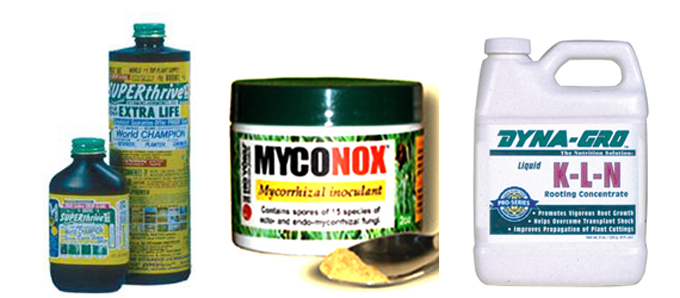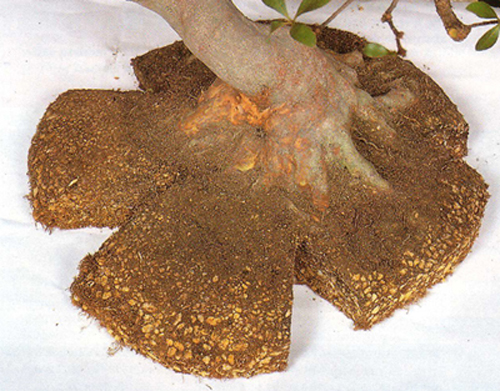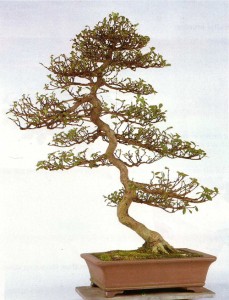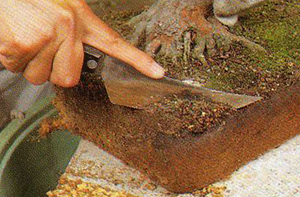 A freshly transplanted Black pine. The photo is from our Masters’ Series Pine book.
A freshly transplanted Black pine. The photo is from our Masters’ Series Pine book.
Fall transplanting
It’s fall transplanting season here in the north country. One advantage to transplanting in the fall is that the tree is fully recovered when the spring season starts, so no top-growth time is lost. The reason this works is that roots experience strong growth in the fall, long after the top has shut down. So by the time the tree wakes up in the spring, the roots are fully recovered.
Top pruning in the fall
It can be a good idea to top prune when you transplant, especially if the roots have been severely disturbed (less foliage for the compromised roots to support). However, too much top pruning when transplanting, especially in the fall, can stress a tree. Beyond that, I am still experimenting with the right mix of root-versus-top pruning on my larches, and the jury is still out on just how much I can get away with. In general, much depends on variables like the type tree, where you live, when in fall you transplant, what transplanting aids you use, aftercare, etc.
 Daddy’s little helpers. These three items are indispensable when it comes to transplanting. Surperthrive is a vitamin and hormone plant tonic, Myconox helps replace the all-important mycorrhizal fungi, and Dyna-Gro K-L-N is a rooting compound that is formulated to reduce stress and encourage growth.
Daddy’s little helpers. These three items are indispensable when it comes to transplanting. Surperthrive is a vitamin and hormone plant tonic, Myconox helps replace the all-important mycorrhizal fungi, and Dyna-Gro K-L-N is a rooting compound that is formulated to reduce stress and encourage growth.
Recycling
The photos and text from here down are from an 2010 Bonsai Bark post titled Transplanting Tips: An Uncommon Technique.
 Pieces of the pie. From Bonsai Today issue 39.
Pieces of the pie. From Bonsai Today issue 39.
Keeping some roots undisturbed
The technique shown here is particularly good if you want to replenish the soil while leaving some of the roots undisturbed. Doing this lessens stress and hastens recovery.
Pot sizes and shapes
This technique is useful when you want move a tree from a larger to a smaller pot, or into a pot that has a different shape. It also works when you want to replenish some of the soil and then put the tree back into the same pot and is particularly useful for repotting forest plantings.
Potbound trees
If the roots aren’t well enough established to hold the soil together when you take the tree out of the pot, then this technique won’t work. Ergo, this technique is particularly good when dealing with potbound trees.
 Before. A well developed Satsuki azalea in the wrong pot.
Before. A well developed Satsuki azalea in the wrong pot.
 Cutting corners. Because you’re going from a rectangular pot to a round pot, you start by cutting off the corners.
Cutting corners. Because you’re going from a rectangular pot to a round pot, you start by cutting off the corners.
 Removing the bottom roots. In almost all cases, you want to remove the lower roots. This encourages roots to spread out rather than grow down; because the tree mirrors the roots, it encourage the above ground growth to spread, which is want you usually want with bonsai. Another reason to remove the bottom roots is to make more space to replenish the soil.
Removing the bottom roots. In almost all cases, you want to remove the lower roots. This encourages roots to spread out rather than grow down; because the tree mirrors the roots, it encourage the above ground growth to spread, which is want you usually want with bonsai. Another reason to remove the bottom roots is to make more space to replenish the soil.
Want more?
Here’s the original post in its entirety.
For trees which do not like their roots disturbed (like azaleas), this is a great technique. I do have a question about a purchased tree, and the soil that you are adding is different (drains better). Does this impede water absorption in the soil left undisturbed? Can you address when not to use this technique? Thanks, Carolee
Thanks Carolee,
Water absorption can be an issue with old soil and compacted roots. I’m sure you would need to be aware of this and the difference in the two soils when you water.